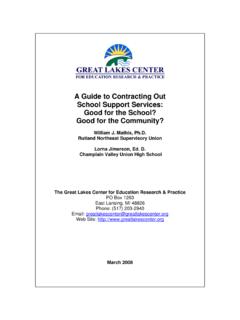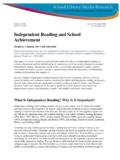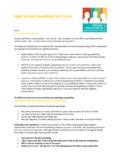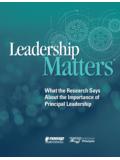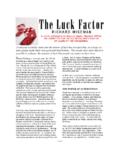Transcription of Good Schools Checklist - School Improvement and …
1 good Schools ChecklistBy Nicholas Abbey President Victorian Council of School OrganisationsIncluding:Leadership and visionSchool governanceManagement and valuesTeaching and learningCurriculumTechnology and communicationPartnerships and communityJoined-up changePerformanceResources and facilitiesThe Book of Checklists 313. Management and values Do key School leaders have good people management skills? Is there genuine warmth between students and teachers? Is the School a safe, respectful place? Does the School greet visitors in a friendly and helpful way?
2 Is the reception area comfortable? Are office staff able to handle inquiries efficiently? Is there a well-publicised policy about values, behaviour and relationships? Does it apply to all School community members? How is the success of the policy monitored - and by whom? Are conflicts and complaints managed well? Is a proper process for handling any concerns or complaints made clear in a leaflet?5. Curriculum How is the School addressing the right of all students to curriculum breadth, depth and balance, and to high standards in all learning areas, not just some of them?
3 Is there a narrow focus on literacy and numeracy creating a divided curriculum between the so-called basics and key learning areas such as science, the arts, history and languages? Does the School have a vision of quality languages education for all students? What is the practical progress towards this? What is the percentage of students who are bilingual? How does the curriculum support students to explore concepts in depth, and enable teachers to connect new ideas with students personal experiences and insights? To what extent is the curriculum planned by the School to respond to local needs, interests and priorities?
4 Is the School part of a cluster of primary and secondary Schools ? Do teachers have the opportunity to plan and integrate key learning areas from a P-10 or P-12 perspective? Does the School provide clear guidelines about the curriculum and the expectations for students at each year level?1. Leadership and vision Is there a clear vision and direction which the School needs to move toward? Do the School s leaders openly and objectively discuss not only the School s achievements but also the challenges in developing a truly 21st century education for all students?
5 Is there broad agreement that leadership is dispersed within Schools , not only confined to formal leadership positions? Are parents encouraged and supported to play leadership roles in the School ? Are students of all backgrounds routinely involved in some form of substantive leadership? For example as learning technology leaders or in student action School governance How are the principal and leadership team, teachers, parents and students involved in shared decision-making? Does the School s governing body ( School council or board) add value to the School and students?
6 Does the School council/board reflect the School s demographics? Does the School have a clear and coherent plan for the future that includes shared School -family-community goals? Does the School publicly display its shared vision and goals in understandable, explicit terms to its community in a variety of ways? 4. Teaching and learning Do School documents and the School s leaders convey a strong sense of continuous Improvement and innovation in teaching and learning? Do School leaders draw attention to their use of educational research?
7 Are teachers given time for professional development and resources to plan and work collaboratively to develop the most effective teaching and learning? Do families and teachers have opportunities to learn together as to how to best collaborate to improve student achievement? How is the School working toward culturally and socially inclusive teaching and learning? Does the School have a cultural and social inclusion policy and plan? How does the School assist all students to have a strong mix of both deep academic knowledge and applied/practical learning in classroom and community settings?
8 Is the School developing really personalised learning that is built around all learners needs, aspirations, talents, interests and right to all-round personal development? Do students receive regular feedback that is timely and focused or is most of the feedback an explanation of where students lost marks in an assessment? How are all students supported to acquire a strong capacity to speak clearly, publicly, competently and confidently?32 Teacher Learning Network8. Joined-up changeTo what extent is the School developing its own broad, joined-up approach to educational change?
9 Evidence may include: A clear and compelling message as to why change is needed A clear, shared vision of what is to be changed and achieved Ownership of change among teachers, parents and students A shared policy framework that joins up all of the changesIs the School developing a joined-up approach involving: The vertical parts of education ( , School clusters, P-12 schooling or a learning community involving a TAFE college, university or kindergarten) The horizontal links with the wider community ( , health agencies, workplaces, businesses, community organisations, and groups such as sporting clubs) Sharing resources such as sport and performing arts facilitiesIs the School an integral part of the local community?
10 Do students take part in a variety of activities including after School community-based sports and other local community activities? Are these local community links listed on the School website? Is the School involved in local community renewal ( , in replanting local areas)?7. Partnerships and community Partnerships create something together that could not be developed by any one person, group or organisation. To what extent does the School link and align the many settings in which students learn, develop and find support? These include the home, workplaces, community organisations, and sports, arts and recreation.

